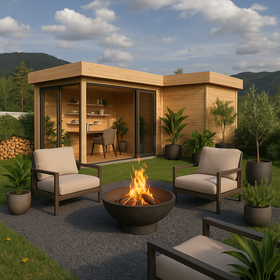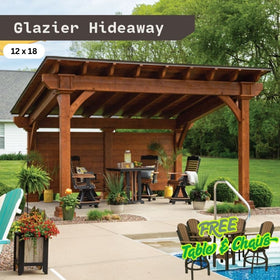512-777-0154

Garden House for Plants: Choosing, Building, and Growing in Your Backyard Greenhouse
Creating a garden house for plants is like giving your greenery its own cozy home. It’s a place where herbs, flowers, and vegetables thrive all year, no matter what the weather does outside.
With the right setup, you can turn your backyard into a lush little world of growth and calm.
1. What is a Garden House for Plants (And Why Do You Need One)?
Before building one, it helps to understand what a garden house for plants really is and why gardeners love it.
Defining the Structure: From "Garden House" to "Greenhouse"
A garden house for plants, or greenhouse, is a sheltered space designed to keep plants growing in comfort. Think of it as a temperature-controlled bubble where your plants live their best life.
Whether it’s rain, frost, or blazing sun, the greenhouse keeps everything stable inside. It’s ideal for both hobby gardeners and anyone ready to grow more than just houseplants on a windowsill.
The Core Benefits: Season Extension and Plant Protection
A garden house doesn’t just look charming. It lets you start growing earlier in the spring and keep your plants happy well into winter. It protects delicate flowers and crops from pests, heavy winds, and cold snaps.
You can grow warm-weather favorites like tomatoes and basil, even when it’s chilly outside. The result? A longer, more rewarding gardening season.
A Perfect Home for Flowers and Produce (The 'Floral' vs. 'Plant' Use)
Some gardeners fill their greenhouses with orchids, geraniums, and colorful blooms. Others use them to grow leafy greens, peppers, and herbs. Many do both.
A garden house can easily serve as both a flower retreat and a mini vegetable farm. It’s a space where beauty and practicality blend perfectly.
2. Choosing the Best Garden House for Your Backyard
Your garden house should fit your space, style, and growing goals. Whether you have a small patio or a large backyard, there’s a structure that fits.
Selecting by Size: Small vs. Large Greenhouses
The size you choose affects how much you can grow. A small garden house for plants is great for tight spaces or beginners. A larger greenhouse offers room to expand, experiment, and grow bigger harvests.
Green House Small and Portable Options (Cold Frames, Mini-Greenhouses)
If space is limited, start small. Cold frames and mini-greenhouses are simple, portable, and affordable. They’re perfect for starting seeds early or protecting a few special plants during colder months.
Backyard Greenhouse Kits and Walk-in Structures
If you’ve got room to spare, walk-in greenhouse kits make life easier. They come with clear panels, shelves, and enough space to move comfortably inside. Many gardeners love these for their balance of size, style, and ease of assembly.
Comparing Frame Materials: Durability and Aesthetics
The frame is the backbone of your garden house.
- Wood: Warm and natural but needs occasional care.
- Aluminum: Sleek, light, and rust-resistant.
- Galvanized Steel: Extremely sturdy and built for tough weather.
- PVC: Simple, inexpensive, and great for small DIY builds.
Each material has its charm. Choose one that fits both your climate and your design taste.
Glazing Options: Glass, Polycarbonate, and Polyethylene Film
Your greenhouse’s “skin” affects how light and heat move inside.
- Glass is classic and elegant but fragile.
- Polycarbonate offers strong insulation and durability.
- Polyethylene Film is affordable and flexible, but best for temporary setups.
Pick what suits your budget and how often you plan to use your greenhouse.
3. Planning and Building Your Own Plant Garden House
Now comes the fun part: turning your idea into something real.
Location, Location, Location: Maximizing Sun Exposure
Plants crave sunlight, so location matters. Pick a spot that gets at least six hours of light daily. Make sure the ground drains well and isn’t shaded by tall trees or fences.
Facing the greenhouse east or southeast usually gives the best morning light.
DIY Garden House for Plants - Budget-Friendly Options
You don’t need to spend a fortune to build a beautiful greenhouse. Many gardeners create their own using PVC pipes, recycled windows, or old frames.
Hoop houses and upcycled projects add a creative, personal touch while keeping costs low.
Garden House for Plants Plans and Prefabricated Kits
If DIY isn’t your thing, pre-made greenhouse kits make it easy. They come with clear instructions and all the materials you need. These kits range from small starter sizes to large walk-in designs.
You’ll find plenty of options to match your skill level and garden size.
4. The Essential Interior: Outfitting Your Greenhouse
A garden house’s interior is what turns it from a structure into a thriving ecosystem.
Ventilation and Airflow: Critical for Plant Health
Fresh air keeps plants healthy. Without good airflow, moisture builds up and invites mold or disease. Add vents, roll-up sides, or fans to keep things circulating. Your plants will thank you for it.
Heating and Cooling Systems for Year-Round Growing
Consistency is key. Some gardeners use passive systems like water barrels or thermal blankets. Others install heaters, fans, or thermostats for precise temperature control. Whatever you choose, balance is important—too much heat or cold can quickly stress your plants.
Staging, Shelving, and Maximizing Vertical Space
Organization helps you grow more with less space. Use shelves for seedlings, hanging planters for vines, and vertical racks for smaller pots. Keep paths clear so you can move easily while tending to your plants.
5. What to Grow in Your Garden House (Plant-Specific Guides)
Once your greenhouse is ready, it’s time to fill it with life.
The Best Vegetables and Herbs for Greenhouse Cultivation
Tomatoes, peppers, and cucumbers are greenhouse favorites. They love steady warmth and reward you with steady harvests. Basil, parsley, and mint also thrive in controlled environments, giving you fresh herbs whenever you need them.
Successfully Cultivating Garden House Floral Plants
For flower lovers, a greenhouse opens up new possibilities. Orchids, geraniums, and begonias enjoy the stable warmth and filtered light. You can extend the bloom season of annuals or grow tropical plants that wouldn’t survive outside.
Starting Seeds and Propagating New Garden House Plant Stock
Your garden house doubles as a nursery. Start seeds early in spring, take cuttings from favorite plants, and experiment with new varieties. It’s a hands-on way to grow your gardening skills alongside your plants.
6. Maintenance and Troubleshooting Your New Plant Home
Every garden house needs a little upkeep to stay in top shape.
Watering Strategies: Drip Systems vs. Manual Watering
Automatic drip systems keep watering consistent and save time. Manual watering, though slower, lets you spot problems early. Many gardeners use a mix of both depending on the season.
Integrated Pest Management in a Closed Environment
Even greenhouses can attract pests. The trick is to stay alert. Use sticky traps, natural oils, or beneficial insects like ladybugs to keep things under control. Avoid harsh chemicals that can upset the balance.
Winterizing Your Structure for Maximum Plant Survival
Before winter, check for drafts and reinforce weak spots. Insulate panels, clean out old debris, and make sure your heating setup is ready. A bit of prep ensures your plants stay healthy through the colder months.
Making Your Garden House Dream a Reality
A garden house for plants is more than a structure; it’s a year-round gardening companion. It keeps your plants protected, your hobby alive, and your backyard beautiful.
Whether you build it yourself or buy a kit, it’s a space that grows with you. With a little sunlight, care, and patience, your garden house will become your favorite spot to unwind, nurture life, and watch your plants flourish.









